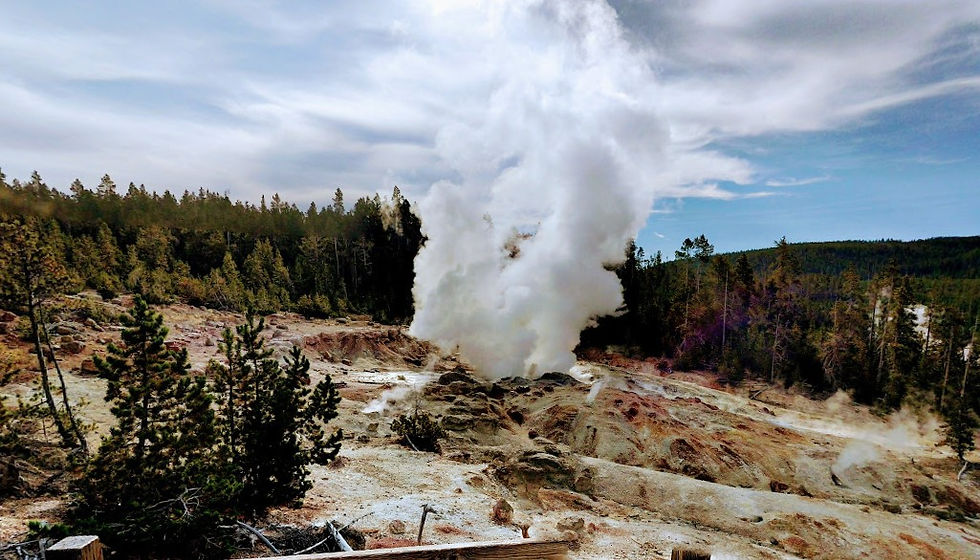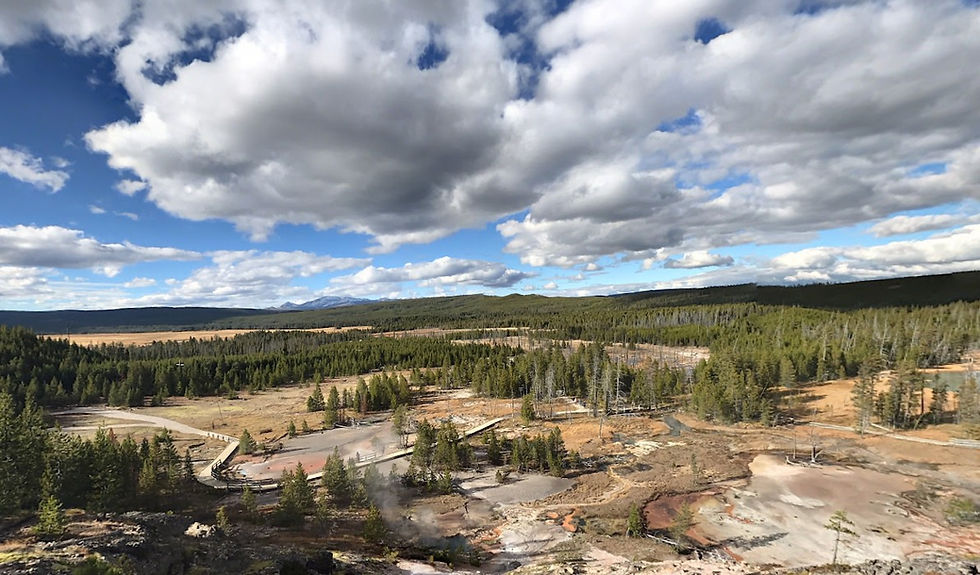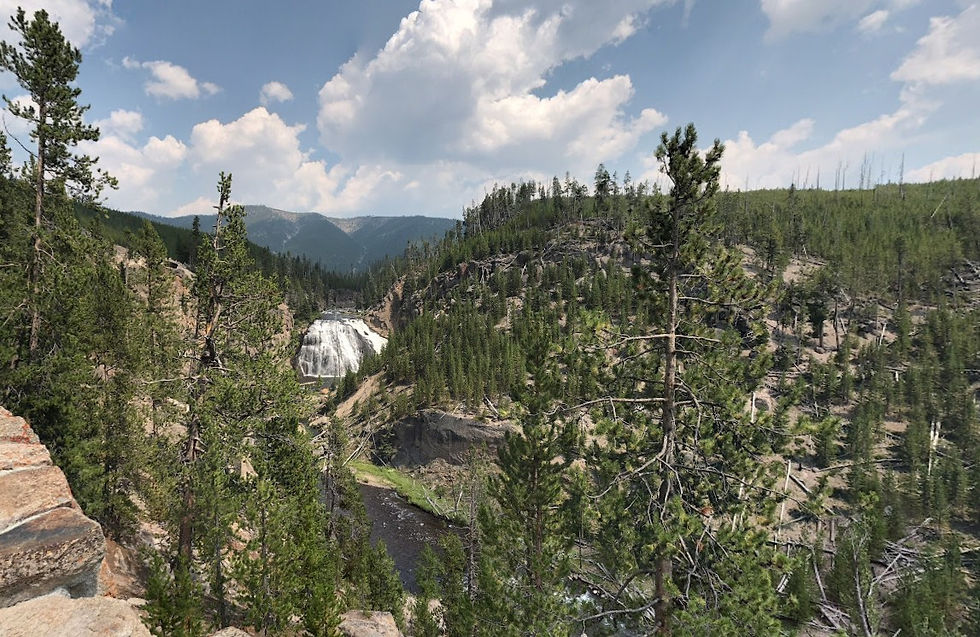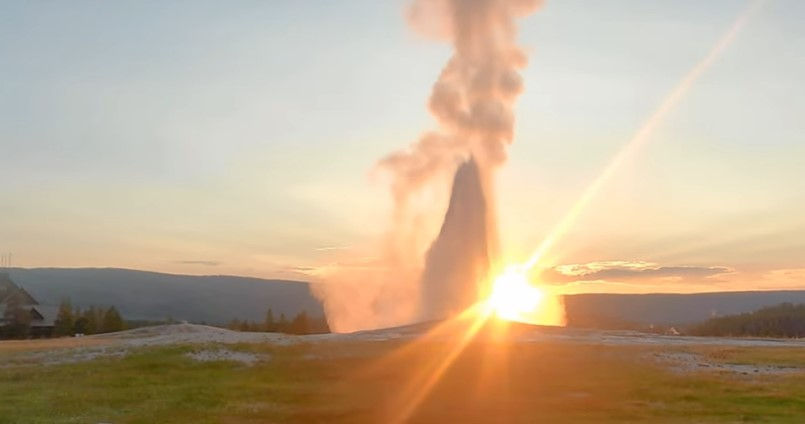Yellowstone Itinerary: Touring the Geysers on the Western Grand Loop Road
- Eric Beuning
- Mar 24
- 10 min read
Updated: Apr 21

Yellowstone National Park was my late father’s happy place, and the geyser itinerary he came up with was his polished masterpiece. So, when I decided to write this series of Yellowstone deep dive articles, I wanted to bring the western edge geyser tours into sharp focus.
Yellowstone is home to the world's largest concentration of geysers and geothermal features. The majority of which can be found along the western edge of the Grand Loop Road with most, being found on the western edge of what many locals call “The Lower Loop.”
This geyser itinerary that my father created was designed to fit into one jam-packed day, starting at the northern entrance to Yellowstone in Gardiner, Montana, and Mammoth Hot Springs.
Driving Strategy for Yellowstone’s Geysers
His strategy to this itinerary was that you could get up at the ass crack of dawn, and pack a picnic lunch in a cooler while chugging coffee and continental breakfast doughnuts. Then strike out to beat the crowds and tourist traffic jams. What he found worked best, and I’ve confirmed in my own travels, is that you can drive past some of these features if they look too crowded and pick them up along the way back to your home base in the north end of the park.
Pro Tip
However, I’ve found that the expanded parking in Yellowstone in recent years means you can take your time to hit each of the major features in a single day. So, If you’re starting the day in Gardiner, Mammoth, or the Paradise Valley, you could still see everything on this geyser itinerary and still stay elsewhere like Canyon Village, Grant Village or even Colter Village.
Yellowstone can be immense, and it's hard to know exactly where to how and how much time to spend at each place in the geyser tour. It's understandable to want to have someone in the know lead the way, rather than spend a day stressing out behind the wheel. If you're feeling this, I recommend
If navigating the winding roads and geyser traffic jams of Yellowstone doesn’t sound like your ideal day, this full-day guided tour from West Yellowstone is the perfect alternative. Instead of watching the road, you’ll be watching for bison, elk, geysers, and waterfalls—all from the comfort of an air-conditioned vehicle led by a knowledgeable local guide.
This small-group tour hits many of the park’s top highlights, including Old Faithful, Grand Prismatic Spring, and the Upper and Lower Falls of the Grand Canyon of the Yellowstone. Your guide handles all the logistics, parking, and timing—so you can focus on snapping photos and soaking in the epic views.
It’s a great choice for first-time visitors, families, or anyone who wants a deeper understanding of Yellowstone’s geology and wildlife without the hassle of maps, crowds, or rental car confusion. With lunch, snacks, and hotel pickup from West Yellowstone included, it’s an easy and enriching way to explore one of America’s most iconic national parks.
Book your tour at: West Yellowstone: Yellowstone Day Tour Including Entry Fee.
Starting Point: Gardiner, Montana & Mammoth Hot Springs

This itinerary starts in Gardiner, Montana, which is the northern gateway to Yellowstone. After passing through the Roosevelt Arch, follow the road south to Mammoth Hot Springs, a fascinating area featuring travertine terraces shaped by underground geothermal activity.
Picnic & Restrooms: Picnic tables and restrooms are available near the Mammoth Hot Springs Visitor Center. This is the best place to have kids use the bathroom with flushing toilets and sinks for handwashing.
How to Best See Mammoth Hot Springs
Mammoth Hot Springs is one of Yellowstone’s most unique geothermal features with cascading travertine terraces formed by hot, mineral-rich water flowing over limestone. The active geology of the area means it’s in a constant state of change.
I find it’s best to start at the boardwalk trail, on the lower terraces which are more accessible. If someone in your group has mobility issues, this is still a maneuverable area, and it offers up-close views of iconic formations like Minerva Terrace and Palette Spring.
For the upper terraces, I think it’s best to drive a scenic loop with overlooks accessible by car. It’s best to visit early in the morning or late in the afternoon to avoid crowds. Which is why my father insisted on starting the day here.
Best Photo Spots
The best pic-worth spots at Yellowstone’s Mammoth Hot Springs start with Minerva Terrace, which has intricate limestone formations and striking contrast between orange, white, and gray hues.

Canary Spring is also known for its vibrant colors. When the weather is cool in the morning it sometimes gives off an ethereal mist.
The Upper Terrace Drive offers panoramic shots of the steaming terraces set against the backdrop of the surrounding mountains. If you’re up for a short hike, head to the Mammoth Hot Springs Overlook near the Upper Terrace for a sweeping view of the entire area. Be sure to bring a wide-angle lens to capture the full scale of this geothermal wonderland.
Drive Time to Next Stop: Approximately 30 minutes to Norris Geyser Basin.
Norris Geyser Basin
Norris Geyser Basin is one of Yellowstone’s hottest and most dynamic geothermal areas. It’s made up of two primary sections, the Porcelain Basin and Back Basin.

Picnic & Restrooms: A picnic area and restrooms are located near the Norris Museum. I remember the museum as being a bit boring for a kid and it is something you could skip if you’re feeling pinched for time.
Pro Tip: There’s a separate primitive picnic area hiding in the forest to the east of Norris Geyser basin. If you need a quiet moment away from the crowds. It’s a great place to stop. I did a little guided meditation here as a petulant teenager in the 90s.
How to Best See Norris Geyser Basin
Steamboat Geyser, the world’s tallest active geyser, capable of eruptions exceeding 300 feet. It’s difficult to time it right, but if you’re lucky it packs a memorable “Wow Factor” for your kids.

The Porcelain Basin portion of Yellowstone’s Norris Geyser Basin tends to have more milky blue pools and steaming vents. If you have a trusty selfie stick, you can get a little extra height to capture stunning azure images that you won’t find in other tourist photos. However, this is the sort of thing that will bore a kid. So, if you’re traveling with little ones, don’t plan to spend a ton of time here.
The Best Hiking Strategy for Norris Geyser Basin
You can hike the Norris Geyser Basin till your feet are blistered in your boots and not feel like you really hit the high notes. The area is rife with little side trails, twists, and turns that lead you to underwhelming steaming mud puddles.
I think the best way to see the high notes of Norris Geyser basin, without wasting time on steaming mud is this.
1. Walk to the Norris Geyser Basin Museum. Face it so the museum is at your 12 o’clock.
2. Take the southwest trail at your 7 o'clock. It will branch left toward Emerald Spring.
3. The trail will continue, and hook to the east as you come to Steamboat Geyser.
4. After seeing Steamboat Geyser take the trail to the southwest.
5. The trail zigzags until it comes to a T at Cistern Spring.
6. Go left and continue following the trail.
7. The trail will wind around past Black Pit Spring, Root Pool, Dishwater Spring, and eventually Mystic Spring.
For my money, everything after Mystic Spring isn’t really all that great. I prefer to double back, hoping to catch a pic at Steamboat Spring on the way. Then get back to the car and drive on.
Optional Stop: Artists Paint Pots
Artist’s Paint Pots is one of those geothermal features that you can skip if you’re pinched for time. They’re basically steaming mudholes, and a few of them are colorful. You have to hike a little over half a mile one way, to be underwhelmed by them.

It’s the sort of thing you can come back to on your way back to Gardiner, or if you have some time to kill. You’re not going to lose any sleep when you get back home for not seeing the artist’s paint pots.
Drive Time to Next Stop: Approximately 25 minutes to Gibbon Falls Picnic Area.
Gibbon Falls & Picnic Area
Picnic & Restrooms: No picnic areas, but vault toilets are available at the nearby Gibbon River Picnic Area.

While it isn’t technically a Yellowstone geothermal feature, Gibbon Falls and the nearby picnic area, are arguably the best place to have a picnic lunch on this geyser tour itinerary. You come across the falls area first, which is little more than an overlook, with some side trails. It’s worth stopping to see if there’s easy parking.
The picnic area is about a quarter mile farther down the Grand Loop Road and has plenty of pull-by parking. This was my dad’s favorite place to pull out a hibachi grill and cook up hot dogs, before taking a gentle stroll along the river.
NOTE: Don’t feel obligated to stop here on my dad’s account. There are plenty of other nice picnic spots nearby and scenic pull-offs swallow down a sandwich ahead.
Drive Time to Next Stop: Approximately 15 minutes to Lower Geyser Basin.
Lower Geyser Basin
The Fountain Paint Pot area in Lower Geyser Basin offers a mix of bubbling mud pots, steaming fumaroles, and spouting geysers. This is another one of the geothermal spots in Yellowstone that I consider optional.
Picnic & Restrooms: Picnic tables are available at Firehole Lake Drive, with restrooms at the Fountain Paint Pot parking lot.
How to See the Lower Geyser Basin
The boardwalk loop passes by colorful hot pools and the frequently erupting Clepsydra Geyser. This is a modest walk, with well-maintained boardwalks that someone with mobility issues can manage. However, it’s a bit of a walk from the main parking area.
The Secret Gem of Lower Geyser Basin

Rather than park and walk the steaming pools around the boardwalk, my father and I prefer to take Firehole Lake Drive. The start of the road is opposite the north entrance to the parking area. If you’re southbound, instead of going right to the parking lot, turn left onto the road to the east.
It will take you past geothermal features like Steady Geyser, Hot Lake, Pink Cone Geyser, Great Fountain, and Firehole Spring. There’s modest parking by them, but you could easily drive by slowly and get a good view.
Firehole Lake Drive joins up with the Grand Loop Road again to take you south.
Drive Time to Next Stop: Approximately 10 minutes to Midway Geyser Basin.
Midway Geyser Basin & Grand Prismatic Spring
Midway Geyser Basin is home to the famous Grand Prismatic Spring, and enough tourists to make you wish there was a deodorant dispenser in the parking lot. It’s the largest hot spring in the United States. Its brilliant colors—ranging from deep blue to vibrant orange and yellow are caused by heat-loving bacteria.
Picnic & Restrooms: There are vault toilets in the parking lot, but no picnic areas and the parking lot really isn’t feasible to use a portable grill. So, you’re limited to eating sandwiches in the car. The nearest picnic area is at Biscuit Basin, a few miles south.
The Best Way to See Grand Prismatic Spring
The boardwalk provides an up-close look at the Excelsior Spring and then loops past the Grand Prismatic Spring. When the trail splits after Excelsior go to the right. You can get closest to it on the Northeastern corner of the loop the fastest this way. Then you can double back the way you came for the most expeditious route.
The Problem with Grand Prismatic

You see a lot of pictures of Grand Prismatic Spring online taken from drone photos, helicopters, and people who zoom in from the overlook trail. While you can hike the overlook, I don’t think it gives you the same effect as being close to it. I honestly think that people who take this hike talk about how amazing the view is to justify the fact that they took the hike.
Instead, I think the best visual bang for your buck is to put a camera on the end of a very long selfie stick. Then raise it up to the max standing at the far northeastern corner of the boardwalk loop!
Grand Prismatic Overlook Trail
Yellowstone’s Grand Prismatic Overlook trail is accessible from Fairy Falls Trailhead. To get there you have to drive about a quarter mile down the Lower Loop to the small parking area by the Steel Bridge Pool. It’s a little over a hike, then you have to climb the hill to get the best view of the Grand Prismatic.
I think this is the sort of thing that you can drive past the first time. If you have time on your way back through, the hike can be a good way to stretch your legs.
Drive Time to Next Stop: Approximately 10 minutes to Biscuit Basin.
Biscuit Basin
Biscuit Basin is a quieter stop with striking thermal features, including Sapphire Pool, a deep blue hot spring, and Jewel Geyser, which erupts frequently. A short trail from the basin leads to Mystic Falls, a beautiful 70-foot waterfall.
Picnic & Restrooms: Picnic tables and vault toilets are available at the parking lot.
Drive Time to Next Stop: Approximately 5 minutes to Old Faithful.
Final Stop: Old Faithful Geyser

The journey concludes at Old Faithful, the most famous geyser in Yellowstone. Eruptions occur roughly every 90 minutes, sending a plume of steam and water up to 180 feet in the air. The area also features the historic Old Faithful Inn, the visitor center, and boardwalks leading to other geothermal features in the Upper Geyser Basin, including Castle Geyser, Beehive Geyser, and Morning Glory Pool.
The best sources for Old Faithful’s eruptions are:

Bucket List Idea: Sunset at Old Faithful
The Old Faithful Inn is expensive and nearly impossible to get a room, but if you were to stay there, or someplace relatively nearby like Grant Village. Then I would plan to spend sunset at Old Faithful.
Conclusion
Touring Yellowstone’s geysers along the western Grand Loop Road is an unforgettable experience, showcasing some of the most powerful and colorful geothermal features on Earth. My father spent years and multiple trips figuring out what was worth your time and what the little gems hiding amongst the big-name geothermal features.
If you're feeling overwhelmed, or you want to enjoy a guided tour, I highly recommend the West Yellowstone: Yellowstone Day Tour Including Entry Fee.
Spots tend fill up fast, so it's wise to reserve early, but I honestly think it's the best way to experience Yellowstone's geysers without having to drive yourself.
To learn more about Yellowstone and other outdoor adventures you can follow Eric Beuning’s Author Page.



Comments